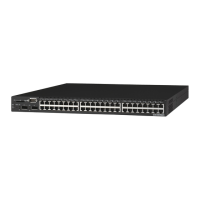Parameter Command
spmanager user
After using the add spmanager user command to configure a user, use the set user
command to configure the user’s parameters: role and target.
Synopsis: set spmanager user <name> role <role name> target <target>
Example: set spmanager user user11 role operator target 172.26.25.179
NOTE: The range of a role name is admin, operator, user and user defined role(s).
To add a user role, see the add spmanager global role command in The following
table shows the parameters that can be added using the add command. Summary of
How to Configure the Top Level Parameters on page 136 shows additional
parameters and values that must be set for each parameter after the parameter is
added. When a parameter is shown in the Parameter Level 2 column, the Parameter
Level 1 and Parameter Level 2 parameters must be entered together with the add
command; for example, to add a service processor user, you must enter add
spmanager user <username>; the user must then be configured after adding, using
the set command. on page 127.
See the add command for the following second level spmanager parameter: user on
page 130.
spmanager global role
After using the add spmanager global role command to add a user role, use the set
command to configure the user role’s privileges -the device management actions.
Synopsis: set spmanager global role <name> privilege power <yes|no> coldest
<yes|no> directcommand <yes|no> pxe <yes|no> snmp <yes|no> lan <yes|no> user
<yes|no> alert <yes|no> sol <yes|no> bmctime <yes|no> sel <yes|no> sensor <yes|no>
spconsole <yes|no> devconsole <yes|no> rdp <yes|no>
Example: set spmanager global role role_aa privilege power yes pxe yes
NOTE: See the add command for the following second level spmanager parameter:
global role on page 131.
sshd protocol
Use the set sshd protocol command to set the SSHD protocol version to either 1 or
2 or both (1,2 or 2,1). Default is 2,1.
Synopsis: set sshd protocol <1|2|1,2|2,1> rootlogin <yes|no> port <num>
Example: set sshd protocol 1 rootlogin no port 22
NOTE: Using this command is not recommended. Changed SSHD protocol version
or SSHD port may cause some features from the web interface to fail.
146 MergePoint® SP Manager Installer/User Guide

